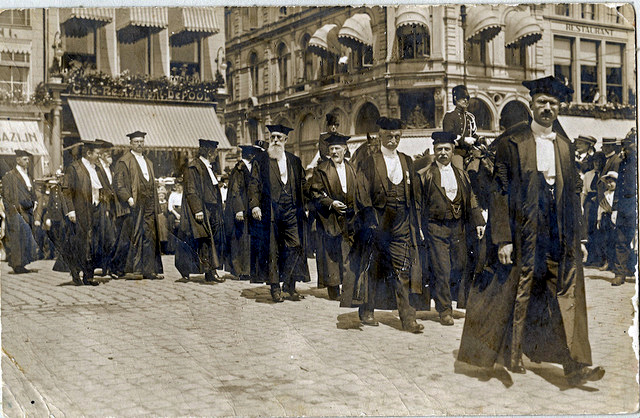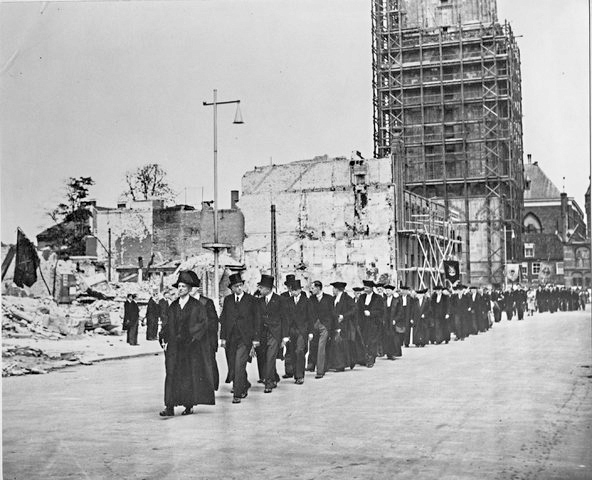waybackmachine
The cortègeA reflection of the ever-changing university
Looking at a random photo of the cortège in Groningen, you might just think nothing had changed in the past few centuries. Whether it’s a picture from 1870, 1906, or 2021, they all depict a line of academics in black woollen robes, white bands, and a velvet beret striding through the city centre.
We say striding, because obviously a cortège doesn’t just saunter. It moves slowly, dignified. From under their berets, the professors observe the world around with a knowing and academically distant look.
Occasionally, they smile benignly or give a quick nod, but no one ever laughs out loud or greets anyone they might know.
Spectators
The formal procession at the opening of every new academic year on the first Monday in September always draws many spectators. As is tradition, the route starts at the Academy building at the Broerstraat. It goes past the Grote Markt and ends at the Martini church.
The photos from past years make it look as though time has stopped. Only the black and white, sepia, or colour tones of the pictures say something about when they were taken. And while many things are still the same as they were approximately two hundred years ago, some things have definitely changed.

Invisible
Some of those changes are invisible, though. The pictures don’t show that for centuries, the cortège walked through the city centre on the third Tuesday of September. It only moved to the first Monday in 1971, and that’s where it’s stayed ever since. The procession also doesn’t divulge anything about the innate hierarchy, but it was there. Originally, the professors who’d been at the university the longest were in front. It wasn’t until later that they were grouped by faculty.
The photos do show the size of the cortège, which says a lot about the position of academic education. Around 1870, the university was an exclusive place to work and study. There were only twenty-two professors, so the cortège was only ten metres long.
These days, the UG employs around four hundred professors, but it’s never caused a traffic jam between the Broerplein and the Grote Markt. No more than a quarter of the current generation joins the annual procession; the rest thinks it’s a pretty old-fashioned ritual.
Male-dominated
The most interesting thing the photos show, however, is how male-dominated the Groningen university was for centuries. The older photos of the cortège show absolutely no women. Somewhere in the back of a photo dating from June 1945, you can spy a woman in a skirt suit. But she’s not part of the exclusive club of professors that’s walking far ahead of her.
Nevertheless, twenty-five years before this picture was taken, the first female professor had been appointed at the UG: botanist and genetics professor Tine Tammes (1871-1947). She appears in plenty of drawings, paintings, and photographs, but there’s no proof that Tammes was ever part of the cortège. Perhaps that was still considered too modern?
How times have changed. According to the Women Professors Monitor, 27.6 percent of UG professors were female (which is still too little according to some; the UG is aiming for 33 percent by 2025). There will be a time that half of the procession consists of women. In fact, the cortège has been led by a woman for the past few years in the form of rector magnificus Cisca Wijmenga (although she does walk behind the male beadles).

Décor
Something else that’s changed is the décor. Early in the twentieth century, the procession moved through the quiet, low-traffic streets of Groningen. High up on his horse, a field marshal would keep an eye on the professors as they entered the Grote Markt. Throngs of people have come to watch the procession along its route, which also passes well-known pub and restaurant De Pool (which used to be Vindicat’s main haunt).
De Pool no longer exists. The north side of the Grote Markt, where the German occupiers had made their home, was destroyed in a battle in April of 1945. The pub was destroyed with it. The replacing new builds included the ABN AMRO offices and former department store V&D.